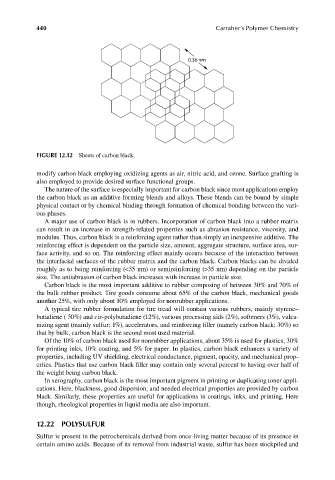Page 477 - Carrahers_Polymer_Chemistry,_Eighth_Edition
P. 477
440 Carraher’s Polymer Chemistry
0.36 nm
FIGURE 12.12 Sheets of carbon black.
modify carbon black employing oxidizing agents as air, nitric acid, and ozone. Surface grafting is
also employed to provide desired surface functional groups.
The nature of the surface is especially important for carbon black since most applications employ
the carbon black as an additive forming blends and alloys. These blends can be bound by simple
physical contact or by chemical binding through formation of chemical bonding between the vari-
ous phases.
A major use of carbon black is in rubbers. Incorporation of carbon black into a rubber matrix
can result in an increase in strength-related properties such as abrasion resistance, viscosity, and
modulus. Thus, carbon black is a reinforcing agent rather than simply an inexpensive additive. The
reinforcing effect is dependent on the particle size, amount, aggregate structure, surface area, sur-
face activity, and so on. The reinforcing effect mainly occurs because of the interaction between
the interfacial surfaces of the rubber matrix and the carbon black. Carbon blacks can be divided
roughly as to being reinforcing (<35 nm) or semireinforcing (>35 nm) depending on the particle
size. The antiabrasion of carbon black increases with increase in particle size.
Carbon black is the most important additive to rubber composing of between 30% and 70% of
the bulk rubber product. Tire goods consume about 65% of the carbon black, mechanical goods
another 25%, with only about 10% employed for nonrubber applications.
A typical tire rubber formulation for tire tread will contain various rubbers, mainly styrene–
butadiene ( 50%) and cis-polybutadiene (12%), various processing aids (2%), softeners (3%), vulca-
nizing agent (mainly sulfur; 1%), accelerators, and reinforcing filler (namely carbon black; 30%) so
that by bulk, carbon black is the second most used material.
Of the 10% of carbon black used for nonrubber applications, about 35% is used for plastics, 30%
for printing inks, 10% coating, and 5% for paper. In plastics, carbon black enhances a variety of
properties, including UV shielding, electrical conductance, pigment, opacity, and mechanical prop-
erties. Plastics that use carbon black fi ller may contain only several percent to having over half of
the weight being carbon black.
In xerography, carbon black is the most important pigment in printing or duplicating toner appli-
cations. Here, blackness, good dispersion, and needed electrical properties are provided by carbon
black. Similarly, these properties are useful for applications in coatings, inks, and printing. Here
though, rheological properties in liquid media are also important.
12.22 POLYSULFUR
Sulfur is present in the petrochemicals derived from once-living matter because of its presence in
certain amino acids. Because of its removal from industrial waste, sulfur has been stockpiled and
9/14/2010 3:42:09 PM
K10478.indb 440 9/14/2010 3:42:09 PM
K10478.indb 440

